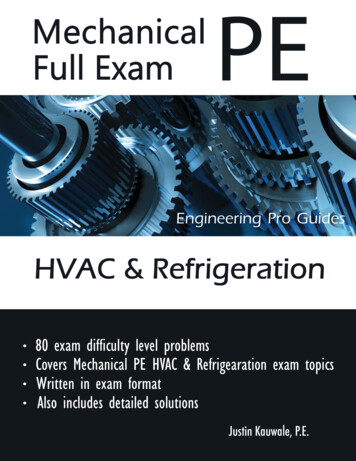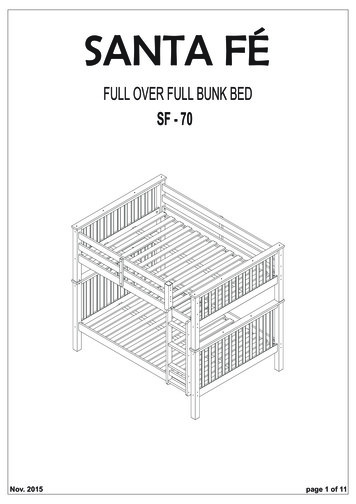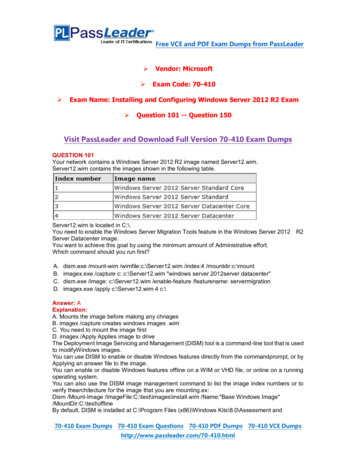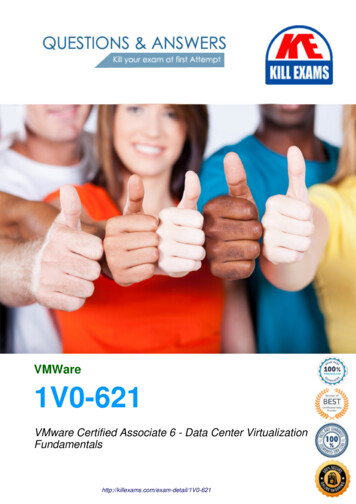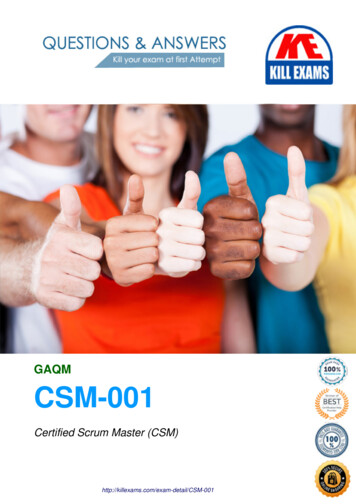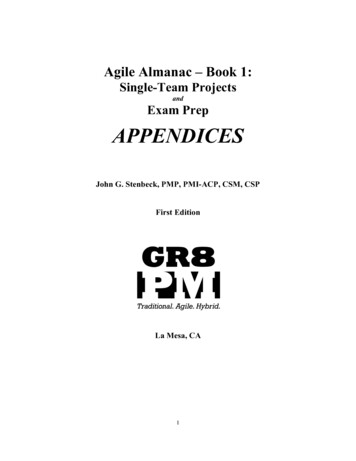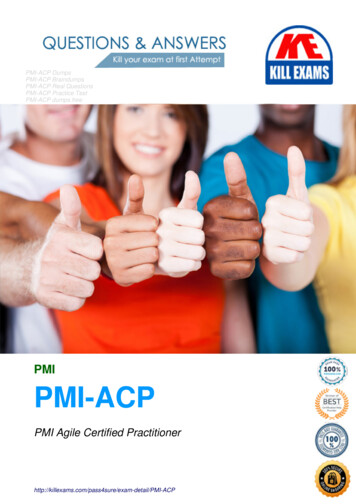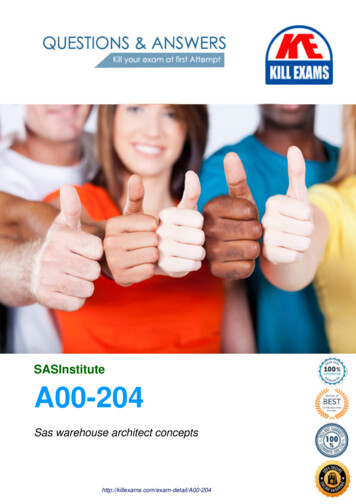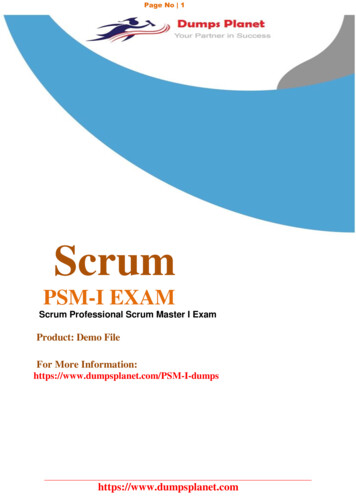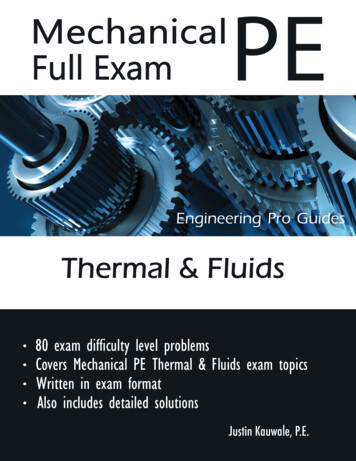
Transcription
MechanicalFull ExamPEEngineering Pro GuidesThermal & Fluids80 exam difficulty level problemsCovers Mechanical PE Thermal & Fluids exam topicsWritten in exam formatAlso includes detailed solutionsJustin Kauwale, P.E.
SECTION 1INTRODUCTIONhttp://www.engproguides.com
IntroductionTable of Contents1.0 Introduction . 21.1 Key Concepts and Skills . 21.2 Units . 52.0 Disclaimer . 53.0 How to use this Book . 54.0 Recommended References . 94.1 Mechanical Engineering Reference Manual . 94.2 Engineering Unit Conversions Book . 94.3 Schaum's Outline of Thermodynamics for Engineers, 3rd Edition . 94.4 Schaum's Outline of Fluid Mechanics and Hydraulics, 4th Edition . 104.5 ASHRAE Handbooks . 10Introduction-1http://www.engproguides.com
1.0 INTRODUCTIONOne of the most important steps in an engineer's career is obtaining the professionalengineering (P.E.) license. It allows an individual to legally practice engineering in the state oflicensure. This credential can also help to obtain higher compensation and develop a crediblereputation. In order to obtain a P.E. license, the engineer must first meet the qualifications asrequired by the state of licensure, including minimum experience, references and the passing ofthe National Council of Examiners for Engineering and Surveying (NCEES) exam. EngineeringPro Guides focuses on helping engineers pass the NCEES exam through the use of freecontent on the website, http://www.engproguides.com and through the creation of books likesample exams and guides that outline how to pass the PE exam.The key to passing the PE exam is to learn the key concepts and skills that are tested on theexam. There are several issues that make this key very difficult. First, the key concepts andskills are unknown to most engineers studying for the exam. Second, the key concepts andskills are not contained in a single document. This exam tests the key concepts and skillsrequired to pass the Mechanical - Thermal & Fluids Mechanical P.E. Exam.1.1 KEY CONCEPTS AND SKILLSHow are the key concepts and skills determined?The key concepts and skills tested in this sample exam were first developed through an analysisof the topics and information presented by NCEES. NCEES indicates on their website that theP.E. Exam will cover an AM exam (4 hours) followed by a PM exam (4 hours) and that the examwill be 80 questions long, 40 questions in the morning and 40 questions in the afternoon. TheThermal & Fluids Mechanical PE exam will focus on the following topics as indicated byNCEES. (http://ncees.org/engineering/pe/):I.Principles (32 questions)A) Basic Engineering Practice (6 questions)1 Engineering terms and symbols2 Economic analysis3 Units and conversionsB) Fluid Mechanics (6 questions)1 Fluid properties (e.g., density, viscosity)2 Compressible flow (e.g., Mach number, nozzles, diffusers)3 Incompressible flow (e.g., friction factor, Reynolds number, lift, drag)C) Heat Transfer Principles (e.g., convection, conduction, radiation) (6 questions)D) Mass Balance Principles ((e.g., evaporation, dehumidification, mixing)) (4 questions)E) Thermodynamics (7 questions)1 Thermodynamic properties (e.g., enthalpy, entropy)2 Thermodynamic cycles (e.g., Combined, Brayton, Rankine)3 Energy Balances (e.g., 1st and 2nd laws)Introduction-2http://www.engproguides.com
SECTION 2AM SESSION QUESTIONShttp://www.engproguides.com
QUESTION 1Honey has a dynamic viscosity of 1,000 poise, a specific heat capacity of 0.6 cal/g-oC, and adensity of 0.05 oz/mL. The kinematic viscosity of honey, in ft2/sec, is most nearly?(A) 0.76(B) 7.1(C) 25(D) 30QUESTION 250 GPM of water flows through a 2-1/2" pipe and then branches into (2) pipes shown in thefigure below. If the velocity in the 1-1/2" pipe is measured at 4 ft/sec, then what is the velocitythrough the 1" pipe?(A) 3.9 ft/sec(B) 5.6 ft/sec(C) 7.2 ft/sec(D) 9.1 ft/secMechanical PE - Thermal and Fluids Full ExamAM Session Questions -1http://www.engproguides.com
QUESTION 19What is the air to fuel ratio? Assume the equation is balanced.(A) 10.1𝐶4 𝐻10 6.5(𝑂2 3.76𝑁2 ) 4𝐶𝑂2 5𝐻2 𝑂 24.44𝑁2(B) 12.9(C) 14.8(D) 15.4Mechanical PE - Thermal and Fluids Full ExamAM Session Questions -12http://www.engproguides.com
QUESTION 37A compressor has a pressure ratio of 10. Air enters the compressor at 70 F. If the air leaves ata temperature of 600 F, then what is the isentropic efficiency of the compressor?(A) 0.97(B) 0.93(C) 0.86(D) 0.81QUESTION 38A hydraulic pump must pump 100 GPM of a fluid with a specific gravity 1.55 to power ahydraulic system. The total pressure loss in the hydraulic system is 15 psi. Assume that thefriction loss in the piping is 4 psi. What is the minimum motor horsepower required of the pump.Assume the pump has an efficiency of 55% and the motor has an efficiency of 95%.(A) 0.5 HP(B) 0.75 HP(C) 1 HP(D) 2 HPMechanical PE - Thermal and Fluids Full ExamAM Session Questions -23http://www.engproguides.com
QUESTION 39A sensor is placed in a 2-inch, steel, schedule 40 pipe to measure the velocity pressure of thecooling water passing through the pipe. The velocity pressure is measured as 0.5 psi. What isthe velocity of the cooling water?(A) 2.1 ft/sec(B) 5.7 ft/sec(C) 8.6 ft/sec(D) 12.1ft/secMechanical PE - Thermal and Fluids Full ExamAM Session Questions -24http://www.engproguides.com
QUESTION 40Which of the following is not a benefit of installing an intercooler and compressing air in twostages as opposed to compressing air in a single stage?(A) There is an increase in efficiency in the multi-stage compression process with intercooler ascompared to the single stage compression.(B) There is an increase in volume in the multi-stage compression process with intercooler ascompared to the single stage compression.(C) There is a reduced amount of work done by compression in a multi-stage compressionprocess with inter cooler as compared to the single stage compression.(D) There is a decrease in the exiting temperature in the multi-stage compression process withintercooler as compared to the single stage compression.Mechanical PE - Thermal and Fluids Full ExamAM Session Questions -25http://www.engproguides.com
SECTION 3PM SESSION QUESTIONShttp://www.engproguides.com
QUESTION 41A manufacturer provides the viscosity for a fluid as 0.41 centipoise. The density of the fluid is60 lbs/ft3. A pump is used to pump 100 GPM of this fluid through a cooling system that has atotal pressure drop of 100 ft of head. What is the mechanical horsepower required to pump thisfluid?(A) 0.2 horsepower(B) 2.5 horsepower(C) 3.6 horsepower(D) 4.5 horsepowerQUESTION 42A compressor is used to compress air from 14.7 psi to 225 psi. The air enters the compressorat a temperature of 100 F. What is the resulting enthalpy of the air?The answer is most nearly,(A) 134 Btu/lbm(B) 176 Btu.lbm(C) 263 Btu/lbm(D) 293 Btu/lbmMechanical PE - Thermal and Fluids Full ExamPM Session Questions -1http://www.engproguides.com
QUESTION 78A steam power plant operates at a maximum pressure of 500 psia and a low pressure value of14.7 psia. 50 lbm/hr of the steam is extracted from the turbine at 50 psia and is directed to theopen feedwater heater. The maximum temperature is 1000 F. 510 lbm/hr is directed to thecondenser. The temperature of the condensate at point 7 is 130 F. What is the resultingtemperature at point 1?(A) 200 F(B) 210 F(C) 220 F(D) 230 FMechanical PE - Thermal and Fluids Full ExamPM Session Questions -27http://www.engproguides.com
SECTION 4AM SESSION SOLUTIONShttp://www.engproguides.com
SOLUTION 1Honey has a dynamic viscosity of 1,000 poise, a specific heat capacity of 0.6 cal/g-oC, and adensity of 0.05 oz/mL. The kinematic viscosity of honey, in ft2/sec, is most nearly?Kinematic viscosity is defined as:The specific heat capacity is irrelevant.ν 𝜇𝜌The dynamic (or absolute) viscosity is irrelevant:The density is:lbf1 Pa s 0.020885 ft 2𝑙𝑏𝑓 𝑠𝜇 (1000 𝑝𝑜𝑖𝑠𝑒) 2.0910 poise𝑓𝑡 2𝑃𝑎𝜌 0.05𝑜𝑧 0.0625 𝑙𝑏𝑚 28317 𝑚𝐿𝑙𝑏𝑚 88.4 33𝑚𝐿1 𝑜𝑧1 𝑓𝑡𝑓𝑡Therefore the kinematic viscosity is:𝑓𝑡2𝑙𝑏𝑚 2𝑙𝑏𝑓 𝑠𝑓𝑡 3𝑠 0.76 𝑓𝑡ν 2.09 32.2𝑓𝑡 288.4 𝑙𝑏𝑚𝑙𝑏𝑓𝑠The correct answer is (A) 0.76Mechanical PE - Thermal and Fluids Full ExamAM Session Solutions -1http://www.engproguides.com
SOLUTION 20An open feedwater heater is supplied with 200 lbm/hr of water at 70 F and steam from theturbine at 100 lbm/hr at 300 F. Assume the pressure of the water and steam is 14.7 psia. Whatis the resulting enthalpy and mass flow rate of the mixture?The first step is to find the enthalpy of the entering conditions.200 lbm/hr of water at 70 F (14.7 psia):𝑆𝑎𝑡𝑢𝑟𝑎𝑡𝑒𝑑 𝑠𝑡𝑒𝑎𝑚 𝑡𝑎𝑏𝑙𝑒, 𝑠𝑢𝑏𝑐𝑜𝑜𝑙𝑒𝑑 𝑙𝑖𝑞𝑢𝑖𝑑, 70 𝐹: ℎ𝑙𝑖𝑞𝑢𝑖𝑑 38.08Steam from the turbine at 100 lbm/hr at 300 F (14.7 psia):𝑆𝑢𝑝𝑒𝑟ℎ𝑒𝑎𝑡𝑒𝑑 𝑠𝑡𝑒𝑎𝑚 𝑡𝑎𝑏𝑙𝑒, 300 𝐹, 14.7 𝑝𝑠𝑖𝑎: ℎ𝑠𝑡𝑒𝑎𝑚 1,192.7Now you should mix the two incoming streams via the lever ���𝑚̇𝑙𝑖𝑞𝑢𝑖𝑑 ℎ𝑙𝑖𝑞𝑢𝑖𝑑 𝑚̇𝑠𝑡𝑒𝑎𝑚 ℎ𝑠𝑡𝑒𝑎𝑚 𝑚̇𝑚𝑖𝑥 ℎ𝑚𝑖𝑥200𝑀𝑎𝑠𝑠 𝐵𝑎𝑙𝑎𝑛𝑐𝑒 𝑚̇𝑚𝑖𝑥 𝑚̇𝑙𝑖𝑞𝑢𝑖𝑑 𝑚̇𝑠𝑡𝑒𝑎𝑚 𝑏𝑚𝐵𝑡𝑢𝑙𝑏𝑚 38.08 100 1,192.7 300 ���ℎ𝑟ℎ𝑚𝑖𝑥 423 𝐵𝑡𝑢/𝑙𝑏𝑚The correct answer is most nearly, (C) 300 lbm/hr at h 𝟒𝟐𝟎 𝑩𝒕𝒖/𝒍𝒃𝒎.Mechanical PE - Thermal and Fluids Full ExamAM Session Solutions -23http://www.engproguides.com
SOLUTION 31A cooling tower is used to cool 10,000 lbs/hr of condenser water from 105 F to 80 F. If the air isdesigned to enter at ambient air conditions of 85 F/50% relative humidty and leave at 95 F/80%relative humidity, then what is the mass flow rate of air required?The energy from the condenser water is transferred to the air.𝑚̇𝑤𝑎𝑡𝑒𝑟 𝑐𝑝,𝑤𝑎𝑡𝑒𝑟 𝑇𝑒𝑛𝑡𝑒𝑟,𝑤𝑎𝑡𝑒𝑟 ��� 𝑚̇𝑎𝑖𝑟 (ℎ𝑙𝑒𝑎𝑣𝑖𝑛𝑔,𝑎𝑖𝑟 ℎ𝑒𝑛𝑡𝑒𝑟,𝑎𝑖𝑟 )ℎ𝑙𝑒𝑎𝑣𝑖𝑛𝑔,𝑎𝑖𝑟 𝑎𝑛𝑑 ℎ𝑒𝑛𝑡𝑒𝑟,𝑎𝑖𝑟 𝑎𝑟𝑒 𝑓𝑜𝑢𝑛𝑑 𝑢𝑠𝑖𝑛𝑔 𝑡ℎ𝑒 � ���𝑇𝑈 1.0 (105 80 𝐹) 𝑚̇𝑎𝑖𝑟 (55.0 34.6)ℎ𝑟𝑙𝑏𝑚 𝑙𝑏𝑚12,255𝑙𝑏𝑠 𝑚̇𝑎𝑖𝑟ℎ𝑟The correct answer is most nearly, (D) 12,255 lbs/hrMechanical PE - Thermal and Fluids Full ExamAM Session Solutions -36http://www.engproguides.com
SECTION 5PM SESSION SOLUTIONShttp://www.engproguides.com
QUESTION 47A master cylinder compresses the hydraulic fluid to a pressure of 80 psi. Cylinder 2 in thediagram below has a diameter of 6” and Cylinder 1 has a diameter of 1”. What is the ratio ofForce 2 to Force 1.A pressure of 80 psi is exerted on both area 1 and area 2, where pressure is equal to forcedivided by area.80 𝑝𝑠𝑖𝑎 𝐹1 𝐹2 ;𝐴1 𝐴2𝐹2 𝐴2𝐹1 𝐹2 𝐴1 𝐴2 𝐹1 𝐴1𝐷2𝐹2 𝜋 4 𝐷2𝐹1𝜋 462𝐹2 𝜋 4 12𝐹1𝜋 4The correct answer is most nearly, (A) 36.𝐹2 36𝐹1Mechanical PE - Thermal and Fluids Full ExamPM Session Solutions -7http://www.engproguides.com
QUESTION 73Steam enters a closed feedwater heater and normally leaves as a condensate (sub-cooledliquid). However, you notice that vapor is leaving the feedwater heater through the drain in lieuof condensate. Which of the following is most likely true? Assume there have been no changesto the feedwater or steam conditions and flow rates.Since, there have been no changes to the feedwater or steam conditions or flow rate, thensomething must have occurred within the feedwater heater. A feedwater heater is in its basicform a type of heat exchanger. Overtime, the surfaces where heat transfer occurs will build updeposits, which will block heat transfer from one fluid to the other fluid. This buildup is calledfouling. This buildup decreases the heat transfer coefficient. Once the buildup is cleaned, theheat transfer coefficient should be increased.The correct answer is most nearly, (D).Mechanical PE - Thermal and Fluids Full ExamPM Session Solutions -37http://www.engproguides.com
SECTION 6CONCLUSIONhttp://www.engproguides.com
5.0 CONCLUSIONIf you have any questions on this sample exam or any other Engineering Pro Guides product,then please contact:Justin Kauwale at contact@engproguides.comHi. My name is Justin Kauwale, the creator of Engineering Pro Guides. I will be happy toanswer any questions you may have about the PE exam. Good luck on your studying! I hopeyou pass the exam and I wish you the best in your career. Thank you for your purchase!Mechanical PE - HVAC and Refrigeration PM Session Sample Exam 1 Conclusion -1http://www.engproguides.com
SECTION 7DIAGNOSTICS OUTLINEhttp://www.engproguides.com
Mechanical PE Exam – Thermal & FluidsAM Session -Sample Exam Diagnostics#Major 62728293031323334353637383940Principles – Basic Engineering PracticePrinciples – Basic Engineering PracticePrinciples – Basic Engineering PracticePrinciples – Basic Engineering PracticePrinciples – Basic Engineering PracticePrinciples – Basic Engineering PracticePrinciples – Fluid MechanicsPrinciples – Fluid MechanicsPrinciples – Fluid MechanicsPrinciples – Fluid MechanicsPrinciples – Fluid MechanicsPrinciples – Fluid MechanicsPrinciples – Heat TransferPrinciples – Heat TransferPrinciples – Heat TransferPrinciples – Heat TransferPrinciples – Heat TransferPrinciples – Heat TransferPrinciples – Mass BalancePrinciples – Mass BalancePrinciples – Mass
sample exams and guides that outline how to pass the PE exam. The key to passing the PE exam is to learn the key concepts and skills that are tested on the exam. There are several issues that make this key very difficult. First, the key concepts and skills are unknown to most engineers studying for the exam. Second, the key concepts and skills are not contained in a single document. This exam .File Size: 1MBPage Count: 25
